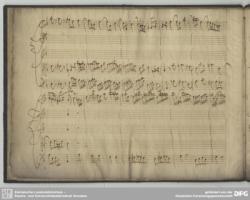

For reasons of decorum, mixed church choirs were not acceptable in Catholic Europe at this time, and since the Pietà’s male wards left the institution during adolescence to take up apprenticeships, it had no option but to train and use exclusively female residents as musicians.


Until as late as 1719 the Pietà failed to replace him, which meant that Vivaldi (together with a colleague, the singing teacher Pietro Scarpari) found himself invited to take over the main task of the maestro di coro: to supply the singers of the institution with a steady stream of new compositions which would attract a well-heeled congregation to the chapel services and so encourage donations and bequests. Francesco Gasparini, who was choirmaster at the Pietà, the Venetian charitable institution for foundlings where Vivaldi worked as a violin master and orchestral director, went on a leave from which he never returned.

In 1713 an event of the greatest importance for Vivaldi’s career occurred. Vivaldi had visited Brescia in 1711 to play in the patronal festival of the Philippine church, Santa Maria della Pace among the compositions acquired by this church in the following year and listed in its account book we find the Stabat Mater for alto and strings, commissioned for the Feast of the Seven Sorrows of the Blessed Virgin, which in 1712 fell on 18 March. Such was the probable origin of the earliest sacred work by him on which a date can be set, the Stabat Mater, RV621 (‘RV’ numbers refer to the standard modern catalogue of Vivaldi’s works by Peter Ryom). But his travels with his father as a ‘jobbing’ player often placed him in situations where commissions for sacred works might have occurred. Raised as a violinist, Vivaldi probably wrote little or no church music until the second decade of the eighteenth century. It then became evident that his production of church music was substantial – over fifty works have survived, and the existence of many more is recorded – and that this music was varied, ambitious in form and expression, and on an artistic level at least equal to that of his concertos. The situation changed only when Vivaldi’s own huge working collection of manuscripts came to light and was acquired for the National Library in Turin. After all, several clerics among composers, Tartini being the most pertinent example, eschewed vocal music altogether. True he was a priest, and for that reason would have been familiar with the sacred repertoire and, one supposes, sympathetic to its aesthetic, but that in itself proves nothing. Almost no church music by him was known to have survived and, since he had never been maestro di cappella at any church, it was difficult to conceive of circumstances in which he would have been asked to provide such music in bulk.
Vivaldi compositions series#
Carolyn Sampson, Susan Gritton and Nathalie Stutzmann have all adorned previous discs in this series Joanne Lunn and Joyce DiDonato are newcomers, both to the series and to Hyperion.Īll of the music on this album is also available as part of the specially priced box set Vivaldi: The Complete Sacred Music: ‘King has given us the ultimate Vivaldi anthology, abundant in energy, rich with emotion, animation, and color, and enshrined in Hyperion's fabled, warm, and incomparable sound’ ( Fanfare, USA).īefore the 1920s, the suggestion that Vivaldi had composed a significant corpus of sacred vocal music would have seemed absurd. Ingeniously, Robert King has again selected a cast of soloists as dazzling as this repertoire, with an ensemble that reads like the current ‘Who’s Who’ of ‘must-haves’ from the performance world of Baroque. Recorded here are a collection of radiant settings: The magnificent Laudate pueri (RV602) and an inventive reorchestration featuring Rachel Brown on flute (RV602a) the Salve Regina (RV618) with motifs creatively modified from one of Vivaldi’s violin concertos (RV319) the exuberant Ascende laeta (RV635) and the beautiful hymn setting of Gaude mater Ecclesia (RV613) and motet Vos aurae per Montes (RV634). Robert King and his consort have again distinguished themselves with this, the penultimate disc of his highly-acclaimed series of Vivaldi’s complete sacred music.


 0 kommentar(er)
0 kommentar(er)
